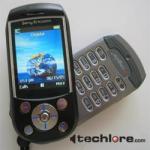
I first caught a glimpse of the Sony Ericsson S710a back at the 2005 CES show in Las Vegas. As an avid tech geek, I'm always looking for a gadget that breaks traditions and offers users a more advanced, or at least different, experience. The Sony S710a is undoubtedly a unique offering that truly stands on its own.
Leading Up to a New Phone
I'm now on my third Sony Ericsson mobile phone. I started with the Ericsson T68, which was one of the first color phones ever produced. This phone was quickly re-released as the Sony Ericsson T68i when Sony and Ericsson merged their mobile units in late 2001. After my T68 experience, I later picked up a Sony Ericsson T610 paired with service from T-Mobile. The T610 was easily the second best handset I ever owned (the Qualcomm QCP-1900 from the PrimeCo days will always hold a special place in my heart), but certainly best in the newer generations of handsets that I've used. It was simple to use, small, good battery life, and every function built in worked like a charm. It was also my first phone with an integrated camera, though it was a token gesture to say the least.
I didn't make the decision to switch carriers lightly; I really liked T-Mobile. However, their delay in making any improvements to their wireless data network had me itching for something faster since GPRS just wasn't doing it for me anymore. In the end, I decided that Cingular's EDGE service and a new phone would be in my near future.
I've been stuck in a dilemma for the past 3 months. The S710a has been ridiculously overpriced at near $400 since its launch, so I nearly opted to forego the Sony S710a in lieu of a Treo 650 from PalmOne, given that the price was identical. Don't get me wrong, the Treo is a fantastic phone, but I can't see myself lugging around a phone that size on a daily basis. Finally, my dream had come true, and the price of the S710a was reduced to $299 before a $100 mail-in rebate. I could easily justify $200 bucks for the S710a.
So I finally hit a local Cingular store, and signed a 2-year contract on a shiny new S710a.
Specs Overview
Brand - Sony Ericsson
Model # - S710a
Form Factor - Compact swivel
Network - GSM 850/GSM 1800/GSM1900
Data - EDGE/GPRS
Camera - 1.3 Mega-pixel with LED light assist
Screen - 240x320 Color LCD 262K
Internal Memory - 32MB
Media slot - Memory Stick Duo (max 128MB)
Speakerphone - Yes
Bluetooth - Yes
MP3 playback - Yes
Out of the Box

The last few times I've bought a cell phone, I've been disappointed when I opened the box. This time I was expecting to see a phone, a battery, a basic wall charger, and a cheap corded handsfree headset. I was pleased that the S710a came with more goodies than just the essentials, which included a hand strap, a 32MB Memory Stick Duo card, a Memory Stick Duo to Memory Stick adaptor, and a 3-slot flash card reader/writer capable of writing to Memory Stick, Memory Stick Duo, the PRO versions of each, and Compact Flash (a perfect accessory for PSP owners). The handsfree headset also doubles as a pair of stereo headphones, which is essential for MP3 playback (more on this below).
One thing I was happy about is that all the accessories but the leather case I currently own work on the S710a, including the desktop charging cradle I bought for my original T68. It's quite a bonus not to have to purchase car cords, travel chargers, and other do-dads all over again.
Continue to page 2 >> [[page]]
The Handset
The design of the S710a is a step in a new direction for the cell phone world. It doesn't conform to the traditional fair of sliders, clamshells, or flat-front phones. Instead, they opted to mount a swivel hinge in the center of the handset when open, thus hiding the number pad and power key. When closed, the swivel resides at the bottom, directly underneath the 4-way directional pad. While this design sets the S710a apart from the pack, it serves more as a nuisance in day-to-day use. However, once you get the hang of opening it, it's not so bad.
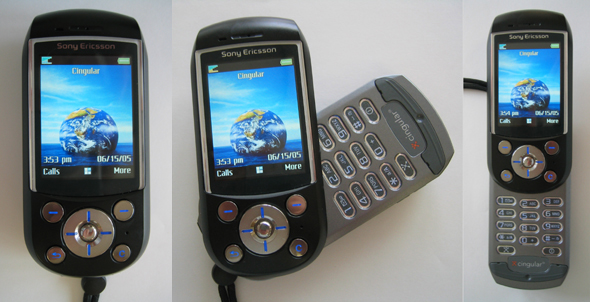
The build of the S710a is nothing short of spectacular. It feels solid in your hand, and never feels cheap during operation. Even the blue backlighting for the keys adds to the phones quality look. The swivel mech itself is equally impressive, which is important considering that things like these are prone to breakage over time. The swivel swings out 180 degrees and locks into place, which can be done in either direction. It does not swivel a full 360 degrees. Forcing it all the way around would break it.
My last two Sony Ericsson phones have used a 5-way joystick (up, down, left, right, and click for enter), which I've become accustomed to over the last few years. Instead the folks over at Sony Ericsson have opted for a more standard 4-way directional pad and center "enter" button.

I can't say I don't like the change since the pad is really nice, but it's a change from what I'm used to. My only gripe with the new layout is that the enter button is too small. The rest of the buttons are intuitive and well placed, except the volume buttons on the upper right hand side, which end up in an odd position (lower left) when the phone is open.
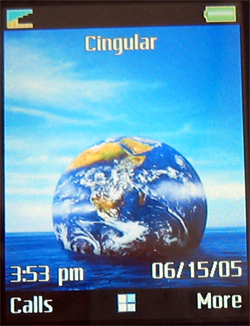
Once thing about Sony is that they pack in a beautiful 240x320 color LCD screen. It's bright, colorful, smooth, and even has a good black level. In fact, it's very similar in quality to the screen on the PSP, and that's a real feat for a cell phone. One thing missing from the feature set of the T610 is the ability to adjust the contrast, which is unfortunate since the screen is excessively bright. I liked having the T610 a little more subdued, making it more comfortable to view at night or in the dark.
The backside of the phone sports the lens cover for the built in digital camera, one of the phones most advanced features. At 1.3 mega-pixels, this phone includes a better camera than my first standalone digital camera.


A slide switch just above the silver frame opens and closes a protective shutter, thus keeping the lens free of dust and debris when not in use. This is a huge improvement from the prior Sony Ericsson phones I've owned. My only gripe here is that the cover vibrates when a loud ringtone is played, making the tones sound less pretty and more irritating. I discovered that it won't vibrate if you hold your finger on the cover while it's playing something through the speaker.
<< Return to page 1 | Continue to page 3 >> [[page]]
Setting it Up
Switching from the T610 to the S710a was completely painless, thanks to Bluetooth technology. One thing I've always hated is having to type in all my contacts from one phone to another, which can take hours if you have a big phonebook. I'm no stranger to Bluetooth, which has become a required feature on any phone I'll ever own (at least until there's something better). I remember sending my contacts from my T68 to my T610 using Bluetooth, but I was forced to send them one-by-one. Regardless, it was still better than typing everything in by hand.
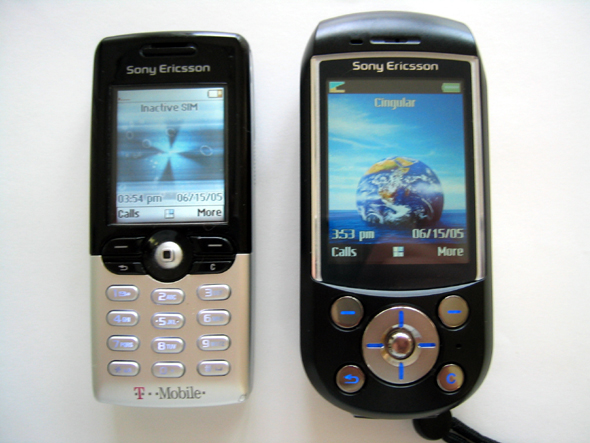
This go around was a lot less painful, since the T610 has an option to "Send All", which then prompted me to select either IRDA or Bluetooth. Once I selected Bluetooth, it was magic! 5 minutes later, every contact (about 60 in total) on my T610 was now on my S710a. Even cooler was that any picture associated with a contact on the T610 was automatically sent along with it. Very cool! It only took 15 minutes in total to migrate everything, including pictures and ringtones, to my new phone.
The phone comes preloaded with numerous ringtones and themes. This was the special Star Wars edition phone, so the Star Wars theme was loaded right out of the box. This highly advertised theme was really disappointing. The special Star Wars content includes:
- 2 wallpapers - one of Luke, Han, Leia, and Chewy; the other of Darth Maul
- 2 special ringtones - One of C-3P0 saying one of his worst quotes; the other a TIE fighter sound effect
- 1 preloaded video - A 1 minute clip of the AT-AT battle from Empire Strikes Back
- 1 game demo - The first level of the Star Wars: Episode III mobile phone game.
I wasn't sure what to expect in terms of Star Wars content, but the wallpapers are not that good, the sound bites are terrible, and the video is useless (but does show-off what the phone can do). Plus, you'd think they'd give you the full version of the game since this is a "special edition" phone! I'll be deleting everything to clear up memory for more valuable stuff.
<< Return to page 2 | Continue to page 4 >> [[page]]
Using the S710a
All things considered, the S710a operates nearly identically to the T610, so I felt right at home as soon as I picked it up. Of course, there are some additions that I didn't have before like instant messaging and the media player. But, when you have a good feel to how the Sony Ericsson line of phones work, you can do just about anything you want to in a matter of seconds.
One annoyance I'll point out is the delay on the main menu screen. Using the directional pad to switch from one icon to another takes a good second or so, which is highly irritating when you're used to zipping around on the main screen. There's nothing I can do but learn to live with it.
Making Calls
If the primary reason of owning it is to make phone calls, it should be able to do that well... right? The S710a isn't disappointing for voice calls, but it could be better. It gets better reception in areas that other Cingular customers in my vicinity struggle with, but the phone needs to be in the open position for best results. The earpiece is loud enough to hear on the expressway, but the position of the microphone causes problems. Instead of mounting it at the very bottom of the phone, Sony chose to put the mic hole to the right of the directional pad. It often rubs against my face during conversations, which makes an unpleasant static-like noise.
The Camera
The integrated 1.3 mega-pixel digital camera in the S710a is truly remarkable. The integrated camera on a cell phone is typically a gimmick, but allows you to add small snapshots to your contacts in the phone book. While the S710a is not a replacement for a quality 3 mega-pixel digital camera, I would not describe it as "gimmicky".
What makes the S710a truly unique is that it feels like a real cameral when taking snapshots. Instead of holding the phone vertically like most camera-phones, the S710a is held horizontally in camera mode. This orientation puts the capture button at the top, just where you would expect the capture button to be on a real camera.
Sony also built in a ridiculously bright white LED light, which is activated by the lock switch or in the settings menu during a camera session. This light serves to make shooting pictures in low-light situations possible.
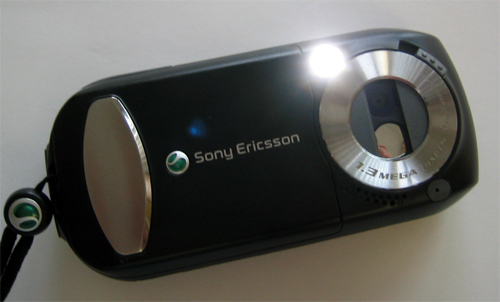

Unfortunately, this always on LED tends to blind subjects looking at the camera. Too bad Sony didn't give the option to use it as a flash...
This is a real camera folks, and it snaps some pretty good pictures. Don't expect much in terms of night performance, but photos taken in good lighting conditions turn out really well. The camera does exhibit the same "over-sharpening" effect I've seen in other Sony digital cameras, but it's nothing that photo editing software can't fix in 2 seconds. All in all, the S710 camera is implemented perfectly.

Sony S710a (1280x960) vs. T610 (288x352).
Images taken seconds apart. Not edited. Click for full size.
<< Return to page 3 | Continue to page 5 >> [[page]]
Media Player
Since MP3 players are the craze these days, Sony opted to include MP3 playback in the S710a. Songs can be transferred to either the internal 32MB memory, or a Memory Stick Duo card that's inserted into a slot on the side of the phone. No matter how hard I've tried to avoid the overpriced Memory Stick format, Sony is notorious for shoving proprietary formats down consumer's throats.
The thought of having MP3 playback built into the phone intrigued me at first. But, leave it to Sony to screw it up by limiting the Memory Stick Duo slot to 128MB cards maximum. It's 2005 for cripes sake! What is Sony thinking?! The MP3 player COULD have been useful. I WOULD have used it if I could have bought a 512MB card and filled it with music. UNFORTUNATELY, 128MB is just too limiting when it comes to having room for music and taking pictures.
I did test out the MP3 function by transferring some music to the included 32MB card. Music can be played through a built in speaker on the back of the phone, or through the included stereo ear-buds. Audio quality through the integrated speaker is horrendous, but I wasn't expecting anything more than that anyway. Sound quality through the ear-buds was surprisingly acceptable, especially after I adjusted the 5-band graphic equalizer. I would imagine that it could even be better with some nicer headphones, but Sony decided not to include a standard 3.5mm jack. Hopefully, someone will make an accessory to provide a regular headphone jack.
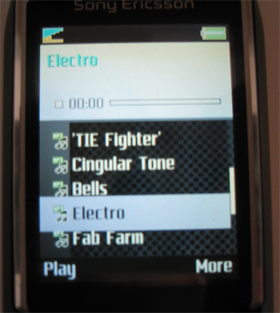
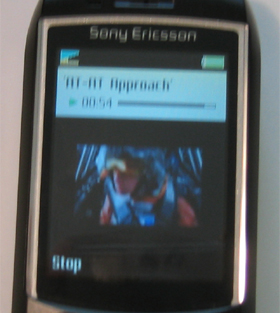
The S710a can also play video clips in the MPEG4 video format, which is another feature rendered useless by the limitation of a 128MB card. I suppose you could fit a 30 minute TV program (an hour at really low quality), but there are other devices more suited to mobile video. This is a token feature at best.
Data
Paired with a laptop equipped with Bluetooth technology, the S710a can be used as a dial-up modem right out of the box. That, combined with Cingular's EDGE high-speed data network (monthly package or pay-per KB required), this proves to be an invaluable tool for users on the go who aren't near a hot-spot. Since one of my main motivations for switching to Cingular was the EDGE service, I was eager to give it a go.
All I can say is that I'll never go back to GPRS again. EDGE loads web pages at about twice the speed of GPRS. I still have to play with download speeds, but I'm expecting an average of about 60 to 70 Kbps, where GPRS averages about 25 to 30. This isn't the kind of speed where you can stream video from a web site, but it does make surfing and downloading e-mails bearable.
Summary
The Sony S710a is not a staple of perfection. It has flaws that make using it a pain. The swivel action is mostly annoying, but provided you have your contacts stored in the phone, you'll rarely need to open it. Its integrated camera is actually useful, but doesn't take shots at night or in dark places very well. The media player is a good idea in theory, but don't expect to carry tons of songs with you on the go unless you feel like buying four or five 128MB memory cards.
At the end of the day you have a phone with great style and some very functional features; the integrated camera, EDGE, color LCD screen, and Bluetooth being the most notable. However, like many other Sony products, inexplicable design flaws that should have been better thought out overshadow many of its features that could have been useful.




